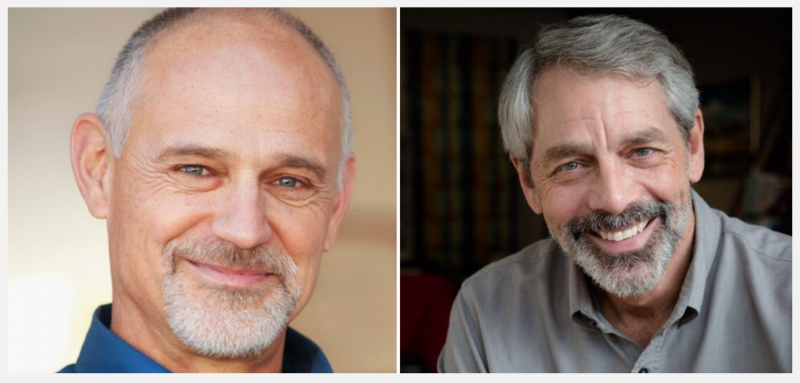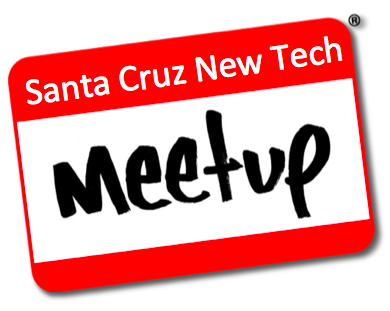Companies
Dave Evans & Dean Hovey to speak on Re-Designing Design Thinking at Feb 5 event

By Julia Sinn
January 16, 2020 — Santa Cruz, CA
(Photo above: Dave Evans & Dean Hovey are the featured guest speakers at the Feb 5, 2020 event. Contributed)
- Design Thinking (Santa Cruz Works New Tech event)
- Keynote speakers: Dave Evans, co-founder of Stanford Life Design Lab, co-author of Designing Your Life, co-founder of Electronic Arts and Dean Hovey, founding partner of IDEO
- Also including: Sibley Simon, Dave Evans, Dean Hovey, TIBCO, Autodesk, Golden Shovel Agency, Spanner, Herbst Produkt.
- Wednesday, February 5, 2020, 6-8:30pm
- Kuumbwa Jazz Center, 320-2 Cedar St., Santa Cruz.
- GET TICKETS NOW (This event is likely to sell out.)
“The essence of design thinking is an optimistic, collaborative, bottom-up, empirical way of encountering the world,” says Dave Evans. “It’s an innovation methodology, a way to think. It’s a methodology that actually creates innovation.”
Co-founder of the Stanford Life Design Lab and co-author with Bill Burnett of the bestselling book Designing Your Life (a new version of which lands on February 25), Evans was on the Apple’s team that created the first-ever computer mouse before he became a co-founder of Electronic Arts. He lives and breathes design thinking—at least in his professional life. Evans and Burnett have shaped and distilled the essential teachings of design thinking into one-day and weekend retreats, online courses, and DYL coaching certification programs.
“Design thinking differentiates itself from other kinds of thinking, especially engineering thinking, by starting with a question, not with an answer,” says Evans.
Yet Evans will be the first to remind anyone that design thinking isn’t dogma.
“Design thinking isn’t the right way to think about every problem. It’s just one tool in your toolbox.”
And it has a dark side.
Wicked Problems
Engineering thinking attempts to solve its way forward—which assumes there is a right answer. Research thinking analyzes its way forward (asking, “Why?”). Business thinking optimizes or scales its way forward (always more, always bigger!). Design thinking starts with empathy and prototypes its way forward.
And just like those approaches to problem-solving, design thinking isn’t exclusively a craft technique, despite the typical connection between “design” and physical things.
Design thinking is best applied to wicked problems: in Dave Evans’s words, “a problem you don’t even know you’re working on before you solve it.” Wicked problems probably don’t have one right answer—in fact, they may not have any “right” answers. They are intrinsically dynamic. They are living problems. Real-world, human problems.
Coined as “human-centered design” during a global conversation in the 1960s and ‘70s, design thinking is now most famously being implemented at places like Stanford’s d.School and international design giant IDEO.
“This way of thinking has become pervasive because it works,” says Dean Hovey, co-founder of Hovey/Kelley Design, which would become IDEO after leading the design of that first mouse for Apple, and one of design thinking’s first evangelists.
So if design thinking can be applied to inventing technologies that don’t exist yet, could it be useful for creating communities, approaching cross-culture challenges, or even forming relationships?
“Historically, design thinking has always been user-centric,” he says. “Who is the ‘user’ of a community? You have members of the community, government, not-for-profits…and each of those have their own motivations and objectives.”
Wicked-er Problems
Although the solidified concept of human-centered design has been around for decades (IDEO was founded in 1978), its popularity and pervasiveness has ballooned in the past decade and a half, especially the tech world. It seems that the world’s recent obsession with design thinking must be reflective of some current cultural zeitgeist, showing up as trends like pop self-growth, emotional intelligence coaching, and conscious leadership retreats.
I tried hard to get both Hovey and Evans to confirm my suspicion that recent interest in design thinking could be associated with current cultural waves, but, unsurprisingly, neither of these wise individuals wanted to venture into speculation with so little evidence.
But after decades of working with and teaching this philosophy, both Evans and Hovey do have overlapping understandings of why design thinking is popular in general—and also why it may be time to re-think it completely.
“It feels human,” says Evans, “and it feels like it supports human feeling.”
Humanity wants to feel human again. As “traditional” industries like agriculture and manufacturing continue to transform or even disappear, the most valuable product has become innovation itself—a product that design thinking generates. Social entrepreneurship continues to increase in popularity and urgency, especially in younger generations, as industrialized society sees the damage it has imposed upon the planet and its inhabitants.
“Rising generations don’t want to be ‘designing a future landfill,’” says Evans, quoting his students. “They want to make good products that have lasting value, and they want to have worthwhile, meaningful experiences that animate who they are as human beings.”
And as society grapples with consciousness-shifting questions around AI, genetic engineering, and the climate crisis, design thinking provides a methodology that isn’t afraid of the unknown.
“Technology is moving faster than people are,” Hovey notes.
The rapid acceleration of technological development and the resulting radical changes in every part of global existence have been, to put it briefly, unimaginable. And how do you solve a problem you can’t even imagine?
The Future of Design Thinking
If Silicon Valley was engineered into existence and San Francisco has been optimized into its version of “existence,” could another, smaller, growing city use this empathetic, observational, collaborative way of thinking to shape itself intentionally?
As expansion in Santa Cruz County continues, citizens, private industry, and governments need a framework to help think about growth, development, gentrification, and other changes in the community—one that aligns with Santa Cruz values and ways of life.
“How do we look at a community as a system and then design a solution to help revitalize that system?” Dean Hovey is asking now.
To that end, Hovey is working on a civic-sized design thinking approach to the revitalization of Watsonville. With leaders and stakeholders in South County, he’s working to develop an appropriate design thinking model for revitalizing communities, particularly rural communities.
Their approach begins with targeting upstream healthcare services. They’re looking at an “under-one-roof” model, where community members can access essential services like healthcare, legal services, educational assistance, and more in one location. Hovey likens this approach to treating the root cause of a physical disease, rather than one symptom at a time.
Most importantly, this method is a collaborative, listening-based building method, based on the behaviors, needs, and expression of the community. When a solution is close at hand, the designers will think about outcomes and consequences, bringing in a diverse group of people who are knowledgeable in specific domains to think about those consequences.
Because there’s one more essential question that designers (of products, of communities, of pedagogies, of anything) need to be asking. A question that designers likely have not been asking until recently: If this is extremely successful, what are the good outcomes and what are the bad outcomes?
Could Hovey and Evans’s teams have asked this question to foresee the unintended consequences of their creation: the carpal tunnel that would doom mouse users’ wrists?
While design thinking doesn’t enable one to turn back time, it does ask generative questions about the past.
“Design thinking doesn’t ask, ‘Did it work?’” says Dave Evans. “It asks, ‘What happened? What was the experience like?’”
At a special New Tech event on February 5, Hovey and Evans will discuss the new landscape of design thinking, including the “dark side” of its unintended consequences. They’ll look back at how design thinking expanded and transformed, and look forward to the implications design thinking has on community-sized, humanity-sized problems.
“It’s time to redesign design thinking,” says Evans. “And Santa Cruz is the place to do it.”








